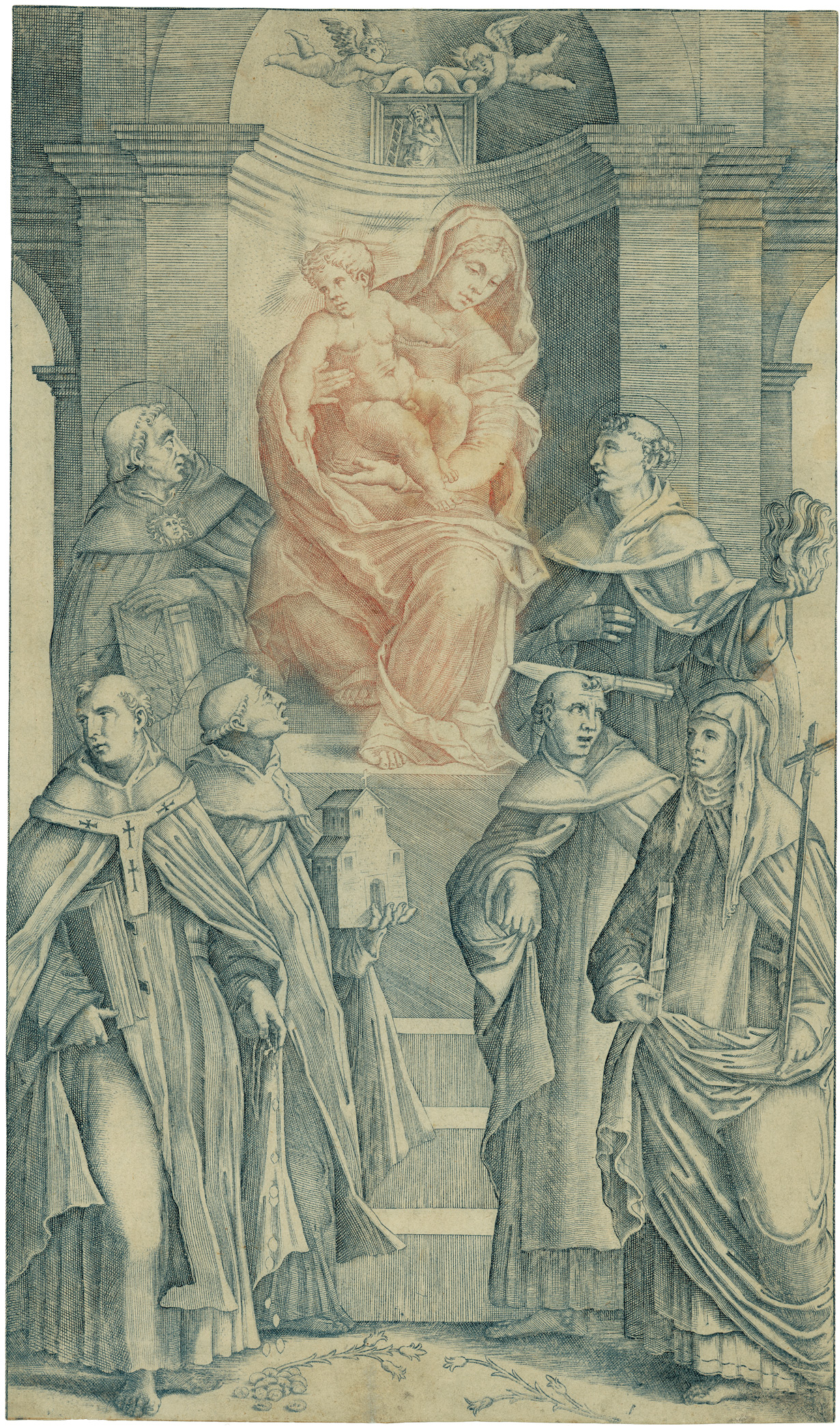Loading the page ...
Agostino Veneziano
(or Agostino dei Musi, ca. 1490 Venice – active until 1536 in Rome)
The Madonna Adored by Saints of the Dominican Order. Engraving, printed à la poupée in red and blue ink. 39.8 x 22.9 cm. B. XIV, 99, 112 II; Passavant VI, 53, 27. Watermark: Bow and Arrow (cf Briquet 815 ff: Venice, Bergamo, Treviso, 1487 onwards).
From the moment our impression came to light, this remarkable sheet by Agostino Veneziano has attracted the interest of art historians, as it is an extremely early, if not the first example of an engraving printed à la poupée. Colour printing from an engraved plate was a technique that was not practiced until the 17th century, when it was invented and perfected by Johannes Teyler in Holland, although there must have been earlier, isolated attempts, as the present engraving shows.
According to Passavant, the composition of this Sacra Conversazione derives from an original by Sodoma. The print was probably done in Rome, where Agostino was active with occasional interruptions from 1516 to 1536, becoming one of the most important students and collaborators of Marcantonio Raimondi. Bartsch, who called the work a pièce rare, describes two states. Our sheet is an impression of the second state, in which the heads of the Madonna and the saints are surrounded by halos. A star is now discernible over the brow of the saint holding the model of a church, while two lilies have been added in the foreground. The narrow borderline defined by parallel- and cross-hatching is missingfrom our impression. Evidently this engraving enjoyed great popularity in its day, for there is a copy made by Mario Cartaro dated 1567, which is enhanced with a decorative border showing New Testament scenes (B. XV, 525, 11).
The engraving is printed on a high-quality, slightly yellowish 16th-century laid paper of North Italian origin, as is indicated by the watermark. In technical terms the impression shows all the features of a print à la poupée. The Madonna and Child are printed in a soft red, which effectively sets them off against the rest of the image and makes them a focus of the composition, while a greyishblue tone has been used for the second coloured ink. Characteristic of this still rudimentary technique of colour printing is the fact that both colours are not clearly separated but in some places melt into each other (e.g. on the left-hand corner of the Madonna’s gar ment over the knee). This was because each engraved line of the plate had to be coloured by hand using what were known as poupées (tampons). As a result of this each impression shows individual differences and thus resembles more a monotype.
Ad Stijnman, author of a forthcoming detailed study on colour printing, has subjected our print to a precise technical and scientific examination. An analysis of the coloured inks by using the fluorescent technique has revealed that the pigments employed had been in use since the Middle Ages and hence are quite possibly contemporary (report available). Nevertheless, Stijnman offers no definite verdict concerning the date of origin of the present impression. In his report of June 30, 2005 he writes: “The date of the colour printing cannot be established, but the lack of wear of the engraved lines and the kind of paper suggest an early impression, such as contemporary to the engraving or around the middle of the 16th century. Observing, however, the way the à la poupée inking and wiping has been carried out it looks normal, or else, at first glance it looks too sophisticated for this period … On the other hand this could indicate that it was not an isolated attempt, but that the printer had a certain experience in this way of printing. Still, this does not give a certain date for the colour printing of this plate. Comparison with a second impression of the same plate or, better, another à la poupée impression from the same period would, of course, be very helpful.” Jan van der Waals (Amsterdam), on the other hand, has no doubt that our print is a 16th century impression. For some time now, van der Waals has been making an intensive study of early colour prints and is familiar with a group of 16th century landscape prints which, although printed only in one colour, nevertheless show a comparable colour scale. In his view there were clear compositional and thematic reasons for the printing of the present impression in two colours, the intention being to emphasize the hierarchical importance of the Madonna and Child. Indeed, the purpose served by this kind of print appears to me to be of crucial importance. Engravings like this one were probably used as devotional objects. They were given a simple frame, glued to a wooden panel or just pinned to the wall (note the fine pinholes at the four corners of the present impression) and served as an inexpensive, universally affordable substitute for religious panel paintings.
The extreme rarity of this type of print can be explained by its function as an article of everyday use and the consequent wear it endured. While it has hitherto proved impossible to date the present sheet beyond reasonable doubt, it is still an extremely fascinating early specimen of an unconventional printing method, testifying to the willingness of Italian engravers and printers of the Cinquecento to experiment.
Minor defects and repairs, slight staining, mainly on the verso. With old collector’s annotations in pencil and pen and brown ink on the verso, but overall in very good condition.
